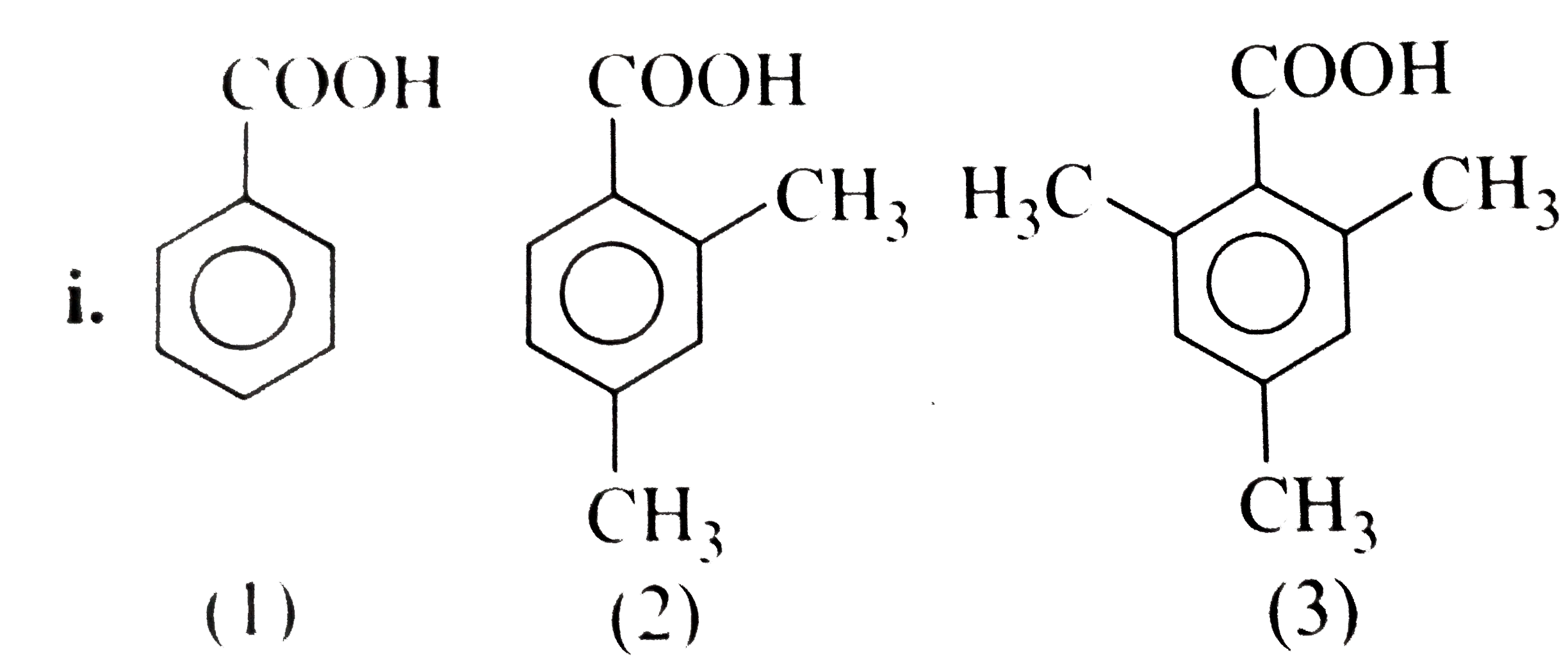Give the decreasing order of acidic character of the following :
(a) (1) Benzene
(2) CH3OH
(3) H2O
(4) CH3SH
(b) (1) CH3CH2COOH
(2) HOCH2CH2COOH
(3) C1CH2CH2COOH
(4) O2NCH2CH2COOH
( c) ![Give the decreasing order of acidic character of the following : (a) (1) Benzene (2) CH3OH (3) H2 O (4) CH3 SH (b) (1) CH3CH2COOH (2) HOCH2CH2COOH (3) C1 CH2 CH2 COOH (4) O2 NCH2CH2COOH ( c) (d) (1) [Fe(H2O)6]^(2 +) (2) [Fe(H2O)6]^(3 +) (3) [A1(H2O)6]^(3 +) (4) [Cr(H2 O)6]^(3 +) ( e) (1) HCHO (2) CH3 CHO PhCHO (4) CH(3)-overset(O)overset(||)(C)-CH(3) (5) R-overset(O)overset(||)C-CI (6) (CH3CO)2 (7) (RCOOR) (8) RCONH2.](https://d10lpgp6xz60nq.cloudfront.net/physics_images/KSV_ORG_P1_C04_E01_001_Q01.png)
(d) (1) [Fe(H2O)6]2+
(2) [Fe(H2O)6]3+
(3) [A1(H2O)6]3+
(4) [Cr(H2O)6]3+
( e) (1) HCHO
(2) CH3CHO
PhCHO
(4) CH3−O∣∣C−CH3 (5) R−O∣∣C−CI
(6) (CH3CO)2
(7) (RCOOR)
(8) RCONH2.
(a) 4>2>3>1[(4) Thiols >(2) Methanol >(3)H2O>(1) Benzene (sp2)]
(i) Thiols are stronger acid than alcohols
(ii) Methanol is a stronger acid than H2O(pKaofCH3OH=15.5,pKa of H2O=15.7) (see Table 4.3)
(b) 4>3>2>1 (−I effect of −NO2>−C1>−OH). In (I)+I effect of Et.
( c) 4>1>2>3[(4)−I effect of five F atoms >(1)−I effect of O atom o position >(2)−I effect of O atom at m position (>(3)LP¯e donation from N atom by resonance]
(d) 3>2>4>1
The acidic character of the complexes is explained on the basis of charge density (ionic charge/ionic size). According to Fajan's rule, small cation and high charge mean more covalent and more ecidic character.
Charge on the central metal : (1)Fe2+,(2)Fe3+,(3)A13+,(4)Cr3+
Ionic radius : A13+<Fe3+<Cr3+<Fe2+
(3) is the strongest acid due to high charge density (high 3+ charge and small ionic radius)
Charge density and acidity order : 3>2>4>1
( e) 1>2>3>4>5>6>7>8 [see Section 4.10.1(f)].
Topper's Solved these Questions
- BOOK - CENGAGE CHEMISTRYCHAPTER - GENERAL ORGANIC CHEMISTRYEXERCISE - Concept16videos
GENERAL ORGANIC CHEMISTRY
- BOOK - CENGAGE CHEMISTRYCHAPTER - GENERAL ORGANIC CHEMISTRYEXERCISE - Comprehension20videos
GENERAL ORGANIC CHEMISTRY
- BOOK - CENGAGE CHEMISTRYCHAPTER - GENERAL ORGANIC CHEMISTRYEXERCISE - Solved Example18videos
GENERAL ORGANIC CHEMISTRY
- BOOK - CENGAGE CHEMISTRYCHAPTER - CLASSIFICATION AND NOMENCLATURE OF ORGANIC COMPOUNDSEXERCISE - Analytical and Descriptive Type3videos
CLASSIFICATION AND NOMENCLATURE OF ORGANIC COMPOUNDS
- BOOK - CENGAGE CHEMISTRYCHAPTER - HYDROGEN, WATER AND HYDROGEN PEROXIDEEXERCISE - Subjective Archive (Subjective)3videos
HYDROGEN, WATER AND HYDROGEN PEROXIDE
Similar Questions
Give the decreasing order of acidic character of the following :
(1) Benzene
(2) CH3OH
(3) H2O
(4) CH3SHView SolutionGive the decreasing order of acidic character.
(a) NO2CH2OH,
(b) C1CH2COOH,
(c) HCOOH,
(d) CH3COOH,
( e) CH3OHView SolutionArrange the following in the decresing order of acidic strength :
(a) H2O,CH3OH,C6H5,OH,CH2COOH
(b)CH3CH2COOH,HOCH,C6H5COOH,ClCH2COOHView SolutionCH3−CH2−CH2−OH+(O)→CH3−CH2−COOH
View SolutionWrite the IUPAC names of the following :
(i)CH3CH=CHCOOH (ii)CH3CH2CH2COOH (iii)C6H5CH2COOH (iv)(CH3)3CCOOH (v)CH3CH2COCH2COOH(vi)(CH3)3CCH2COOH <br> (vii)CH3−C∣OHH−CH2COOHView SolutionCH3−CH2−COOH+NaOH→CH3−CH2−COONa++H2O
View SolutionArrange the following in the decreasing order of acidity :
(i) (1) n−Butanol
(2) Methy1 alcohol
(3) sec-Butanol
(4) rert-Butanol
(ii) (1) HCOOH
(2) CH3COOH
(3) C2H5COOH
(4) C6H5COOH
(5) (CH3)2CHCOOH
(6) CH2C1COOH
(iii) (1) CH3CH2CH2COOH
(2) CH3CH2CHC1COOH
(3) CH3CHC1CH2COOH
(4) CH2C1CH2CH2COOH
(iv) (1) CH3COOH
(2) CH2C1COOH
(3) CHC12COOH
(4) CC13COOH
(v) (1) CH3BrCOOH
(2) CH2C1COOH
(3) CH2FCOOH
(4) CH2ICOOH
(vi) (1) C6H5COOH
(2) p−OHC6H4COOH
(3) p−CH3C6H4COOH
(4) p−C1C6H4COOH
(5) p−BrC6H4COOH
(6) p−BO2C6H4COOH
(vii) (1) o-Hydroxybenzoic acid
(2) p-Hydroxybenzoic acid
(3) 2,6−Dihydroxybenzoic acid.
(viii) (1) HCOOH
(2) C6H5COOH
(3) C6H5OH
(4) HC1
(ix) RCOOH
(2) ROH
(3) RH
(4) NH3
(5) HOH
(6) CH≡CH
(x) (1) Phenol
(2) p-Chlorophenol
(3) p-Nitrophenol
(4) m-Cresol
(xi) (1) Phenol
(2) m-Chlorophenol
(3) m-Nitrophenol
(4) m-Cresol
(xii) (1) Phenol
(2) Benzoic acid
(3) p-Nitrophenol
(4) Carbonic acid
(xiii) (1) Phenol
(2) Benzyl alcohol
(3) Benzene sulphonic acid
(4) Benzoic acid
(xiv) (1) Phenol
(2) p-Chlorophenol
(3) 2,4,-Dichlorophenol
(4) 2,4,6-Trichlorophenol
(xv) (1) Nitroform HC(NO2)3
(2) Cyanoform HC(CN)3
(3) CHC13
(xvi) (1) CH3SO2CH3
(2) CH3NO2
(xvii) (1) CH3BO−OӨ
(2) CH3CHO
(3) CH3COOR.View SolutionGive the decreasing order of acidic character.
(1) NO2CH2OH,
(b) C1CH2COOH,
(c) HCOOH,
(d) CH3COOH,
( e) CH3OH
(2) (a) RCOOH
(b) ROH
( c) H2O
(d) NH3
( e) CH≡CH
(f) RH
(3) (a) HCOOH
(b) PhOH
( c) CH3OH
(d) C2H5OH
( e)CH3C≡CH
(f) CH≡CH,
(g) NH3
(4) (a) CH3COOH
(b) H3O⊕
( c) H2O
(d) C2H5COOH
( e) NH3
(f) CH≡CH
(g) CH2=CH2
(h) CH4
(i) C2H6.
(5) (a) H2O
(b) CH3OH
( c) RC≡CH
(d) H2
( e) NH3
(f) RH
(g) ROH
(6) Basic character of conjugate base of Problem 5.View SolutionWhich of the following is a stronger acid in each of the following pairs ?
(a) CH2(Cl)COOH,CH2(F)COOH (b)CH2(Cl)CH2CH2COOH,CH3COOH,CH3CH(Cl)CH2COOH
(c ) CH3COOH,C6H5CH2COOH (d)m−NO2C6H4COOH,p−NO2C6H4COOH
(e)p−NO2C6H4COOH,C6H5COOH (f)m−OHC6H4COOH,p−OHC6H4COOHView Solutiona. Acid halides, anhydrides, esters and amides, all of them contain (C=O) group but none of them gives test for (C=O) group, i.e., they do not form oximes, hydrazones, and DNP derivatives, etc. Why?
b. Arrange the following in the decreasing order of nucleophilic addition.
i. (1)−CHO
(2)−COCH3
(3)−COOH
(4)−COCI
(5)−CONH2
(6)−COOCH3
(7)−COOΘ
ii. (1)CH3CHO
(2)CH3COCH3
(3)HCHO
(4)CH2H5CH2COCH3
iii. (1)CH3COCH3
(2)C6H5COCH3
(3)C6H5COC6H5
(4)C6H5CH2COCH3
iv. (1)C6H5CHO
(2)ρ−CH3.C6H4.CHO
(3)ρ−OH.C6H4.CHO
(4)ρ−NO2.C6H4.CHO
(5)ρ−CI.C6H4.CHO
v. (1)HCHO
(2)CH3CHO
(3)CH3COCH3
(4)CI3CCHO
c. Arrange the following in the increasing order of ease of hydrolysis.
(1)CCH3COOC2H5
(2)CH3COCI
(3)(CH3CO)2O
(4)CH3CONH2
d. Arrange the following in the increasing order of ease of acid-catalysed esterification of:
i.
ii. (1)CH3CH2COOH
(2)(CH3)2CHCOOH
(3)(CH3)3CCOOH
iii. (1)CH3CH2CH2OH
(2)CH3CHOHC2H5
(3)(CH3)2C(OH)C2H5
e. Arrange the following esters in decresing order of ease of alkaline hydrolysis.
i. (1)HCOOCH3
(2)CH3COOCH3
(3)(CH3)3CCOOCH3
(4)(CH3)2CHCOOCH3
ii. (1)CH3COOCH3
(2)CH3COOC(CH3)3
(3)CH3COOCH(CH3)2
(4)CH3COOCH2CH3
iii. (1)C6H5COOCH3
(2)ρ−CH3O−C6H4−CCOOCH3
(3)ρ−NO2−C6H4−COOCH3
(4)ρ−Cl−C6H4−COOCH3View Solution

